The National Statistics Office (NSO) has revamped the sampling methodology of the Periodic Labour Force Survey (PLFS) from January 2025 to generate high-frequency labour force indicators at a more disaggregated level. The revamped design aims to estimate key employment and unemployment indicators monthly for rural and urban areas, extend quarterly results coverage to rural areas, and estimate employment indicators annually in both usual and current weekly status. The survey will use a rotational panel sampling design with households visited four times in four consecutive months, ensuring a 75% match between consecutive months and 50% between consecutive quarters.
SOURCE PDF LINK :
Click to access PLFS_changes_in_2025_Final.pdf
Click to view full document content

2025 में परिवर्तन
CHANGES IN 2025
भारत सरकार
Government of India
सांख्यिकी और कार्यक्रम कार्यान्वयन भंत्रालय
Ministry of Statistics and Programme Implementation
राष्ट्रीय सांख्यिकी कार्यालय
National Statistics Office
महं, 2025
MAY, 2025
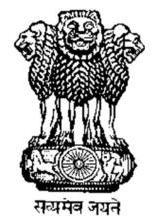
आवधिक श्रम बल सर्वेक्षण (पीगलएफएस) Periodic Labour Force Survey (PLFS)
2025 में परिवर्तन
Changes in 2025

भारत सरकार
Government of India
सांख्यिकी और कार्यक्रम कार्यान्वयन मंत्रालय
Ministry of Statistics and Programme Implementation
राष्ट्रीय सांख्यिकी कार्यालय
National Statistics Office
मई, 2025
May, 2025
(1)) www.mospi.gov.in (7) GoiStats Gov (C)GolStats
Changes in Periodic Labour Force Survey from 2025
I. Introduction
Periodic Labour Force Survey (PLFS) of National Statistics Office
- Since its launch in 2017, information collected in the Periodic Labour Force Survey (PLFS) conducted by National Statistics Office (NSO), MoSPI has been the primary source of statistics on labour force, activity participation of the population and structure of employment and unemployment in the country. These statistical indicators on labour market are required for planning, policy and decision making at various levels, both within and outside government and are also extensively used by various researchers.
- PLFS was launched in 2017 essentially to address the following two objectives
- to estimate the key employment and unemployment indicators (viz. Worker Population Ratio, Labour Force Participation Rate, Unemployment Rate) in the short time interval of three months for the urban areas only in the Current Weekly Status (CWS)
- to estimate employment and unemployment indicators in both usual status (ps+ss) and CWS in both rural and urban areas annually
Usual Status (ps+ss) and Current Weekly Status (CWS) refers to frameworks for determining activity status of person surveyed based on reference periods of last 365 days and last 7 days preceding the date of survey respectively.
3. The quarterly results of PLFS are brought out in the form of Quarterly Bulletins. Till 2024, twenty-five Quarterly Bulletins of PLFS corresponding to the quarter ending December 2018 to quarter ending December 2024 have been released. In these quarterly bulletins estimates of key labour force indicators, viz., Labour Force Participation Rate (LFPR), Worker Population Ratio (WPR), Unemployment Rate (UR), distribution of workers by broad status in employment and industry of work in the Current Weekly Status (CWS) for urban areas have been presented.
4. The annual results of PLFS are brought out in form of PLFS Annual Report covering the survey period July of a specific year to June of the following year along with the unit level survey data. Seven such Annual Reports, covering both rural and urban areas and giving estimates of all important parameters of employment and unemployment in both usual status (ps+ss) and current weekly status (CWS), have been released spanning the period July 2017 to June 2024.
5. Besides the data released with PLFS Annual Reports, unit level data of PLFS for the calendar year i.e. for survey period of January – December of a specific year, has been separately released for the calendar years 2022, 2023 and 2024.
II. Changes in PLFS
- Considering the need for generation of high frequency labour force indicators at a further disaggregated level the sampling methodology of PLFS has been revamped from January $2025^{1}$. The revamped PLFS design is envisaged to address the following objectives
- to estimate the key employment and unemployment indicators (viz. Worker Population Ratio, Labour Force Participation Rate, Unemployment Rate) on a monthly basis for rural and urban areas at all-India level in the Current Weekly Status (CWS)
- to extend the coverage of the Quarterly results of PLFS to rural areas and thereby producing quarterly estimates at the country level in the Current Weekly Status (CWS)
- to estimate employment and unemployment indicators in both usual status (ps+ss) and CWS in both rural and urban areas annually
- Apart from the changes in the PLFS sample design, some additional items of information have also been included in the PLFS first visit schedule from January 2025 onwards.
Changes in PLFS Sampling methodology from 2025
- The sample design of PLFS has been revamped from January 2025. The salient features of the revamped sample design are described below. The estimation procedure for generating estimates following the revamped PLFS design is given in Annexure-II.
Rotational scheme for PLFS:
- A rotational panel sampling design will be used in the survey. The rotational scheme will be of two years duration to accommodate the changes in the frame in the intercensal period; in the sense that the sampling frames for both rural and urban areas will remain unchanged for every two-year duration. In this rotational panel scheme, each selected household will be visited four times in four consecutive months – one with first visit schedule and other three with the revisit schedule. Monthly estimates will be generated for successive months without any break in the series starting from the fourth month, ensuring a $75 \%$ matching between two consecutive months. In addition, the quarterly estimates will be generated for successive quarters, starting from third quarter, ensuring a $50 \%$ matching between two consecutive quarters. Model based estimates will not be generated. Instead, usual design based estimates will be generated. The proposed design aims at generating monthly and quarterly estimates of level parameters of key labour force indicators (i.e., LFPR, WPR and UR) based on CWS data only. Annual estimates of level parameters will be generated based on usual status.
1
Rotational panel design
i. Using Pij to indicate the panel belonging to jth month of the ith year of the two-year period of rotation, the scheme of rotational panel design is described below:
ii. The rotational panel will be fixed for two years, where only one-twelfth of FSUs of annual allocation will be covered in the first month (say, Panel P11) of the first two-year panel with detail listing and canvassing of first visit schedule being undertaken in the selected households.
iii. In the second month, another one-twelfth of FSUs will be covered (say, Panel P12) for canvassing the first visit schedule while the revisit schedule will be canvassed in the selected households of Panel P11.
iv. In the third month, another new panel, say P13 consisting of one-twelfth FSUs will be surveyed with first visit schedule and revisit schedules will be canvassed in the households of the panels P11 \& P12.
v. In the fourth month, households of panels P11, P12 \& P13 will be surveyed with revisit schedule and those of a new panel, say P14 with one-twelfth of FSUs with first visit schedule.
vi. The monthly estimates at all-India level, separately for both rural and urban sector will be generated using full sample size with panels P11, P12, P13, \& P14 from the fourth month and onwards.
vii. In the fifth month, 3 panels – P12, P13 \& P14 will be surveyed with revisit schedule and the earlier panel (P11) will be replaced by a new panel (say, P15) for canvassing first visit schedule. This will continue till end of the two-year panel.
viii. In the second quarter of the first two-year panel, the quarterly estimates at state and all-India level, separately for rural and urban sector will be generated using the fourth visit sample of Panel P11, third visit sample of Panel P12, second revisit sample of Panel P13, first revisit sample of Panel P14 and P15; and the first visit sample of Panel P16.
ix. All the FSUs of the panels P11, P12, …., P124 (each with one-twelfth of total annual FSUs) will be selected independently before commencement of survey in the first month.
x. At the end of the second year of each two-year panel, updated frame will be used for both rural and urban areas.
xi. FSUs of another set of panels P21, P22, …, P224 selected from the updated frame will be made ready before commencement of first month of second year of the two-year panel.
xii. In the first month of the second year of the two-year panel, panel P21 selected from the updated frame will be introduced and the panels P122, P123 and P124 of the old frame will be surveyed.
xiii. Since major changes in the rural-urban frame occurs in the Census years, provision is to be made to generate estimates without break in the series of estimates considering panels from pre- and post-census frames.
The schema of the rotation of panel is provided in the Figure 1.
Figure 1: Panels for the 2-year period: with 3 revisits of each FSU in three consecutive months
| Q1 of Y-1 | Q2 of Y-1 | Q3 of Y-1 | Q4 of Y-1 | Q1 of Y-2 | Q2 of Y-2 | Q3 of Y-2 | Q4 of Y-2 | |||||||||||||
|---|---|---|---|---|---|---|---|---|---|---|---|---|---|---|---|---|---|---|---|---|
| M1 | M2 | M3 | M4 | M5 | M6 | M7 | M8 | M9 | M10 | M11 | M12 | M1 | M2 | M3 | M4 | M5 | M6 | M7 | M8 | M9 | M10 | M11 | M12 |
| $\mathrm{P}_{11}{ }^{*}$ | $\mathrm{P}_{11}$ | $\mathrm{P}_{11}$ | $\mathrm{P}_{11}$ | $\mathrm{P}_{21}{ }^{*}$ | $\mathrm{P}_{21}$ | $\mathrm{P}_{21}$ | $\mathrm{P}_{21}$ | | | | | | ||||||||||||
| $\mathrm{P}_{12}{ }^{*}$ | $\mathrm{P}_{12}$ | $\mathrm{P}_{12}$ | $\mathrm{P}_{12}$ | $\mathrm{P}_{22}{ }^{*}$ | $\mathrm{P}_{22}$ | $\mathrm{P}_{22}$ | $\mathrm{P}_{22}$ | | | | | | ||||||||||||
| $\mathrm{P}_{13}{ }^{*}$ | $\mathrm{P}_{13}$ | $\mathrm{P}_{13}$ | $\mathrm{P}_{13}$ | $\mathrm{P}_{23}{ }^{*}$ | $\mathrm{P}_{23}$ | $\mathrm{P}_{23}$ | $\mathrm{P}_{23}$ | | | | | | ||||||||||||
| $\mathrm{P}_{14}$ | $\mathrm{P}_{14}$ | $\mathrm{P}_{14}$ | $\mathrm{P}_{24}{ }^{*}$ | $\mathrm{P}_{24}$ | $\mathrm{P}_{24}$ | $\mathrm{P}_{24}$ | | | | | | |||||||||||||
| $\mathrm{P}_{15}{ }^{*}$ | $\mathrm{P}_{15}$ | $\mathrm{P}_{15}$ | $\mathrm{P}_{15}$ | $\mathrm{P}_{25}{ }^{*}$ | $\mathrm{P}_{25}$ | $\mathrm{P}_{25}$ | $\mathrm{P}_{25}$ | | | | | | ||||||||||||
| $\mathrm{P}_{16}{ }^{*}$ | $\mathrm{P}_{16}$ | $\mathrm{P}_{16}$ | $\mathrm{P}_{16}$ | $\mathrm{P}_{26}{ }^{*}$ | $\mathrm{P}_{26}$ | $\mathrm{P}_{26}$ | $\mathrm{P}_{26}$ | | | | | |||||||||||||
| $\mathrm{P}_{17}{ }^{*}$ | $\mathrm{P}_{17}$ | $\mathrm{P}_{17}$ | $\mathrm{P}_{17}$ | $\mathrm{P}_{27}{ }^{*}$ | $\mathrm{P}_{27}$ | $\mathrm{P}{27}$ | $\mathrm{P}{27}$ | | | | ||||||||||||||
| $\mathrm{P}_{18}{ }^{*}$ | $\mathrm{P}_{18}$ | $\mathrm{P}_{18}$ | $\mathrm{P}_{18}$ | $\mathrm{P}_{28}{ }^{*}$ | $\mathrm{P}{28}$ | $\mathrm{P}{28}$ | $\mathrm{P}_{28}$ | | | |||||||||||||||
| $\mathrm{P}_{19}{ }^{*}$ | $\mathrm{P}_{19}$ | $\mathrm{P}_{19}$ | $\mathrm{P}_{19}$ | $\mathrm{P}{20}{ }^{*}$ | $\mathrm{P}{20}$ | $\mathrm{P}{20}$ | $\mathrm{P}{20}$ | | ||||||||||||||||
| $\mathrm{P}_{110}{ }^{*}$ | $\mathrm{P}_{110}$ | $\mathrm{P}_{110}$ | $\mathrm{P}_{110}$ | | $\mathrm{P}{210}{ }^{*}$ | $\mathrm{P}{210}$ | $\mathrm{P}_{210}$ | | ||||||||||||||||
| $\mathrm{P}_{111}{ }^{*}$ | $\mathrm{P}_{111}$ | $\mathrm{P}_{111}$ | $\mathrm{P}_{111}$ | | | $\mathrm{P}{211}{ }^{*}$ | $\mathrm{P}{211}$ | | ||||||||||||||||
| $\mathrm{P}_{112}{ }^{*}$ | $\mathrm{P}_{112}$ | $\mathrm{P}_{112}$ | $\mathrm{P}_{112}$ | | | | $\mathrm{P}_{212}{ }^{*}$ | |
- It may be noted that one panel of sample FSUs will be in the sample for 4 consecutive months and the selected households in an FSU will be surveyed for the successive periods during which the FSU remains in the sample. Selected households will be visited 4 times for canvassing the detailed schedule of enquiry of the PLFS. These visits are termed as first visit and revisits. During the first visit, Schedule 10.4: Employment and Unemployment (First Visit) will be canvassed while Schedule 10.4: Employment and Unemployment (Revisit) will be canvassed in all revisits.
- In this scheme, each selected household of a selected FSU will be visited four times, once in each month. To implement the rotational scheme, when a panel appears for the first time in any month with one-twelfth of annual allocation, listing and selection of households will be done in all the selected FSUs in that panel. The first visit schedule will be canvassed in the selected households. The selected FSUs/households will be revisited in the subsequent three months as the panel will remain in the sample for four months. During the revisit, listing and selection of households will not be done afresh. Only the households selected during first visit will be revisited for canvassing revisit schedule. At the time of revisit if any sample household is not found, same will be treated as casualty and a substitute household need not to be surveyed. If any sample household is found to have split, then, among the split
households available in the FSU/sub-block, the household where the head/senior most member of the erstwhile household is available will be covered.
In the rotational panel scheme followed in PLFS upto December 2024, each selected household in urban areas was visited four times, once in each quarter. Unlike the revamped PLFS design in force from January 2025, there was no provision of revisits for the rural samples.
12. Outline of the design: The sampling frame for urban sector is the list of Urban Frame Survey (UFS) blocks as per latest Urban Frame Survey and for rural sector, it is the list of villages as per Census 2011 updated by removing those villages which are urbanized and included in latest UFS (till the time of sample selection). Sometimes, with a view to ensuring uniformity in the size of FSUs and for operational convenience, large villages/UFS blocks are notionally divided into smaller units of more or less equal size, known as sub-units depending on a predefined criteria based on population in the village or number of households in the UFS block. The sector-specific criteria for sub-unit formation are as below:
Rural Sector:
(i) The number of SUs to be formed in the villages (with Census 2011 population of 1000 or more and except some States/UTs) is decided based on projected present population of the village. The criteria for the formation of the SUs are given below:
| Projected Population of the village | Number of SUs to be formed |
|---|---|
| less than 1200 | 1 |
| 1200 to 2399 | 2 |
| 2400 to 3599 | 3 |
| $\ldots$ | $\ldots$ |
(ii) For rural areas of Himachal Pradesh, Sikkim, Andaman \& Nicobar Islands, Ladakh, parts of Uttarakhand (except four districts Dehradun, Nainital, Haridwar and Udham Singh Nagar), Jammu and Kashmir (seven districts Poonch, Rajouri, Udhampur, Reasi, Doda, Kishtwar, Ramban) and Idukki district of Kerala; SU is formed in a village if population as per Census 2011 is more than or equals to 500 . The criteria for the number of SU to be formed are as below:
| Projected Population of the village | Number of SUs to be formed |
|---|---|
| less than 600 | 1 |
| 600 to 1199 | 2 |
| 1200 to 1799 | 3 |
| $\ldots$ | $\ldots$ |
Urban Sector:
Sub-units are formed in the UFS blocks with number of households 250 or more. The number of SUs to be formed within the UFS blocks is decided by the following criteria:
| Number of Households in UFS Block | Number of SUs to be formed |
|---|---|
| less than 250 | 1 |
| 250 to 499 | 2 |
| 500 to 749 | 3 |
| $\ldots$ | $\ldots$ |
Thus, the list of villages / UFS blocks / sub-units (for those villages or UFS blocks where sub-units are formed within) together formed the sampling frame for selection of the First Stage Units.
In the sampling design followed in PLFS upto December 2024, the list of latest available Urban Frame Survey (UFS) blocks was considered as the urban sampling frame for selection of the First Stage Units. For rural areas, list of 2011 Population Census villages (Panchayat wards for Kerala) constituted the rural sampling frame for selection of the First Stage Units.
13. STRATIFICATION OF FSUs
Before stratification, all districts within a particular State/UT are arranged in decreasing order of population as per Census 2011 and the set of districts covering about $95 \%$ of urban population is considered as ‘Category -1’ districts while the remaining are termed as ‘Category – 2 ‘districts.
The primary geographical unit, called basic stratum within a state/UT separately for rural and urban sectors will be formed in the following way:
(i) Stratum Type I: Each ‘Category – 1’ district in ‘Group – A’ States/UTs and State Headquarter District of each of the North Eastern states excluding Assam,
(ii) Stratum Type II: All ‘Category – 2’ districts belonging to ‘Group – A’ states/UTs and districts of all ‘Group – B’ States/UTs (except State Headquarter District of each of the North Eastern states excluding Assam) will be distributed among the NSS regions, and
these NSS regions within each Sector and State/UTs will be considered as Stratum Type II.
The list of ‘Group – $A$ ‘ and ‘Group – $B$ ‘ states are provided in the Annexure 1.
Rural Sector
(i) A Special Stratum comprising of all the uninhabited villages as per Census 2011 is formed at All-India level.
(ii) From the remaining villages, two more strata are formed in each basic stratum:
(a) Stratum 1: Comprising of the villages within 5 Kms from the district headquarter or from a city/town with more than 5 lakh population. This stratum is not formed if there are less than 50 such villages in the Stratum.
(b) Stratum 2: Rest of the villages.
If the number of FSUs in a basic stratum is very small or sufficient number of samples is not allocated (i.e. only one sample FSU is allocated in monthly basis), in those cases the above stratification will not be done.
Urban Sector
Two or more strata will be formed in urban areas of each basic stratum with the following criteria:
(i) Each million plus city as per census 2011 will be considered as a separate stratum.
(ii) Rest of the urban areas of the district will constitute another stratum.
In the sampling design employed for PLFS upto December 2024, for rural areas each NSS region constituted the rural stratum and in urban areas, strata were formed within each NSS region on the basis of size class of towns as per Population Census 2011.
No provision of special stratum of uninhabited villages was present in the stratification followed in PLFS prior to January 2025.
14. Sub-Stratification of FSUs
In the rural sector, two groups of villages are formed within each stratum, except special rural stratum at all-India level, based on the following criteria:
| Group | Population of the village (as per Census 2011) |
|---|---|
| 1 | less than 500 |
| 2 | $\geq 500$ |
Further, the sample size for a particular rural stratum is distributed among these 2 groups in proportion to population. Let r 1 and r 2 be the allocations to Group 1 and Group 2
respectively. The villages within each group will be first arranged in ascending order of number of populations. For all the groups within each stratum, ‘ $\mathrm{r} 1 / 12$ ‘ $>1$ and ‘ $\mathrm{r} 2 / 12$ ‘ $>1$ will imply formation of 2 or more sub-strata in each group. Sub-strata will be demarcated in Group 1 and Group 2 respectively in such a way that each sub-stratum will comprise a group of villages (all SUs of a village considered together) of the arranged frame and have more or less equal population. If the number of FSUs in a particular group is very small or sufficient number of samples is not allocated, no sub-stratum will be formed.
In the urban sector, let ‘ $u$ ‘ be the sample size allocated for an urban stratum. For all strata, if ‘ $\mathrm{u} / 12$ ‘ $>1$, implying formation of 2 or more sub-strata, all the UFS blocks within the stratum will be first arranged in ascending order of total number of households in the UFS blocks as per urban frame. Then sub-strata will be demarcated in such a way that each sub-stratum will comprise a group of UFS blocks (all SUs of a block considered together) having more or less equal number of households. If number of blocks in a particular stratum is very small, no substratum will be formed in the stratum.
The sample design used in PLFS upto December 2024, provision of sub-stratification was there in rural areas but there was no such provision of sub stratification in the urban areas.
15. Criteria for allocation of FSUs in Stratum
A criterion, in terms of population content as described below is proposed to be used for allocation of FSUs (urban blocks or villages or sub-units) in basic stratum Type -I of Category-1 districts:
| FSU allocation criteria for basic stratum – I (Category- 1 Districts) | ||
|---|---|---|
| Size Class | Sector-wise Population (as per projected population as on $1^{\text {st }}$ October 2024) |
Number of FSU allocated (monthly basis) |
| I | Less than 10 lakhs | 1 FSU |
| II | 10 lakhs to 20 lakhs | 2 FSUs |
| III | 20 lakhs to 45 lakhs | 3 FSUs |
| IV | 45 lakhs to 70 lakhs | 4 FSUs |
| V | 70 lakhs to 100 lakhs | 8 FSUs |
| VI | More than 100 lakhs | 10 FSUs |
For each of the basic stratum Type – II within a State/UT, a minimum monthly sample will be allocated using the criteria based on the number of districts within that stratum. The detail of the allocation is given below.
| FSU allocation criteria for Stratum – II | ||
|---|---|---|
| Category | Number of districts in Stratum II |
Number of FSU allocated (monthly basis) |
| I | $1-5$ | 1 FSU |
| II | $6-10$ | 2 FSUs |
| III | 11 or more | 3 FSUs |
16. Sample Size
12,504 FSUs in the rural areas and 10,188 in the urban areas will be surveyed with first visit schedules in each year of the two-year panel. The total sample size of 22,692 FSUs to be covered in each year of the two-year panel has been allocated to State/UTs based on the criteria discussed in section 15, subject to a minimum allocation of 12 FSUs within a stratum.
Prior to the adoption of the revamped PLFS design from January 2025, the total number of FSUs surveyed in PLFS was 12,800. Out of these 12,800 FSUs, 7032 FSUs were surveyed in rural areas and the remaining 5768 FSUs were covered in the urban areas.
17. Selection of FSUs within Stratum / Sub-Stratum
The required number of FSUs from each of the stratum / sub-strata is selected by SRSWOR scheme.
In the sample design followed in PLFS till December 2024, FSUs were selected by probability proportional to size with replacement (PPSWR) scheme, where size was the population of census villages (panchayat ward in case of Kerala) in rural areas and number of households in the UFS block in urban areas. The sample FSUs was drawn from stratum / substratum randomly in the form of two independent sub-samples.
18. Formation of Sub-Division
It has been experienced that in some of the selected FSUs, the actual present population is significantly higher than the projected population/Census population that causes operational inconvenience for listing of all the households. In such a situation, the selected FSU is notionally sub-divided into several smaller units, called Sub-division. The criteria for determining the number of Sub-divisions to be formed in the selected rural (except areas mentioned in 12 (ii)) /urban FSU is given below.
| Approx. present population of the selected SU |
Number of Sub-divisions to be formed |
|---|---|
| less than 1500 | 1 |
| 1500 to 2399 | 2 |
| 2400 to 3599 | 3 |
| 3600 to 4799 | 4 |
| $\ldots$ | $\ldots$ |
The criteria for determining the number of Sub-divisions in rural areas mentioned in paragraph 12 (ii) are as below:
| Approx. present population of the selected SU |
Number of Sub-divisions to be formed |
|---|---|
| less than 750 | 1 |
| 750 to 1199 | 2 |
| 1200 to 1799 | 3 |
| 1800 to 2399 | 4 |
| $\ldots$ | $\ldots$ |
Only one Sub-division is selected randomly after forming the required number of Subdivisions. Further, listing and selection of households are done in the selected Sub-division unit only.
19. Formation of Second Stage Strata (SSS)
Second Stage Strata (SSS) in each FSU will be formed based on the number of members in each household who have completed secondary level of education considering general type of education. In urban FSUs, 4 SSS will be formed, while 3 SSS will be formed in rural areas. A total of 12 households will be surveyed from each of the selected FSUs. Allocation of the sample households among the SSS and criteria for the formation of SSSs are given in the following table.
| Rural | |||
|---|---|---|---|
| SSS | Composition of SSS | Number of persons | Number of households to be surveyed |
| 1 | number of members in the household having a level of general education as secondary ( $10^{\text {th }}$ standard) or above | 2 or more | 4 |
| 2 | 1 | 6 | |
| 3 | 0 | 2 |
| Urban | |||
|---|---|---|---|
| SSS | Composition of SSS | Number of persons | Number of households to be surveyed |
| 1 | number of members in the household having a level of general education as secondary ( $10^{\text {th }}$ standard) or above | 3 or more | 4 |
| 2 | 2 | 4 | |
| 3 | 1 | 2 | |
| 4 | 0 | 2 |
20. Selection of Households
The sample households from each SSS are selected by the SRSWOR scheme.
In the sample design followed in PLFS upto December 2024, from each selected sample FSUs, 8 households were surveyed. The sample households from each SSS were selected by the SRSWOR scheme.
- The salient features of the revamped sample design of PLFS adopted from January 2025 as compared to sampling methodology used in PLFS upto December 2024 have been summarized in Table 1.
Table 1: Comparison of different features between the revamped PLFS sample design adopted from January 2025 and the PLFS sample design used upto December, 2024
| Aspect of the sample design | PLFS sample design followed upto December, 2025 | Revamped PLFS design adopted from January 2025 |
|---|---|---|
| Rotation panel | In the rotational panel scheme followed in PLFS upto December 2024, each selected household in urban areas was visited four times, once in each quarter, in the beginning with first visit schedule in the first quarter and thrice periodically later with revisit schedule in the following three quarters. There was no provision of revisits for the rural samples. This rotational panel scheme ensured that $75 \%$ matching of the samples surveyed between successive quarter for urban areas. |
In the rotational panel scheme adopted in the revamped PLFS sample design employed from January 2025, each selected household is visited four times in four consecutive months -in the beginning with first visit schedule in the first month and other three with the revisit schedule in the following three months for both rural and urban areas. This rotational panel scheme ensures a $75 \%$ matching of the samples surveyed between two consecutive months for both rural and urban areas and $50 \%$ matching in successive quarters. |
| First (or Primary) Stage units (FSUs) of the multistage design |
In the sampling design followed in PLFS upto December 2024, the list of latest available Urban Frame Survey (UFS) blocks was considered as the urban sampling frame for selection of the First Stage Units. For rural areas, list of 2011 Population Census villages (Panchayat wards for Kerala) along with its subsequent |
With a view to ensure uniformity in the size of First Stage Units and for operational convenience, large census 2011 villages and UFS blocks are notionally divided into smaller units of more or less equal size, known as sub-units depending on a pre-defined criteria based on population in the village or number of households in the UFS block. |
Table 1: Comparison of different features between the revamped PLFS sample design adopted from January 2025 and the PLFS sample design used upto December, 2024
| Aspect of the sample design | PLFS sample design followed upto December, 2025 | Revamped PLFS design adopted from January 2025 |
|---|---|---|
| revision constituted the rural sampling frame for selection of the First Stage Units. | In the revamped PLFS design employed from January 2025, the list of census 2011 villages / sub-units (for those census 2011 villages where sub-units are formed within) together formed the sampling frame for selection of the First Stage Units for rural areas. Likewise, the list of latest available UFS blocks / subunits (for those UFS blocks where sub-units are formed within) together formed the sampling frame for selection of the First Stage Units for urban areas. |
|
| Stratification of FSUs | In the sampling design employed for PLFS upto December 2024, for rural areas each NSS region constituted the rural stratum and in urban areas, strata were formed within each NSS region on the basis of size class of towns as per Population Census 2011. No provision of special stratum of uninhabited villages was present. |
In the revamped PLFS sample design, district has been made the primary geographical unit, called basic stratum within a state/UT separately for rural and urban sectors for selecting FSUs for most part of the geography covered. In the remaining parts NSS region has been made the basic stratum. For rural areas provision for stratification has been made within district / NSS region (as the case may be) based on distance of the villages within 5 Kms from the district |
Table 1: Comparison of different features between the revamped PLFS sample design adopted from January 2025 and the PLFS sample design used upto December, 2024
| Aspect of the sample design | PLFS sample design followed upto December, 2025 | Revamped PLFS design adopted from January 2025 |
|---|---|---|
| headquarter or from a city/town with more than 5 lakh population. In case of urban areas million plus cities within district / NSS region has been formed as stratum. A Special Stratum comprising of all the uninhabited villages as per Census 2011 is formed at All-India level has been incorporated in the revamped PLFS design. |
||
| Selection scheme for selecting FSUs | In the sample design followed in PLFS till December 2024, FSUs were selected by Probability Proportional to Size With Replacement (PPSWR) scheme, where size was the population of census villages (Panchayat Ward in case of Kerala) in rural areas and number of households in the UFS block in urban areas. The sample FSUs were drawn from stratum / sub-stratum randomly in the form of two independent sub-samples. |
In the revamped PLFS sample design, the required number of FSUs from each of the stratum / sub-strata is selected by Simple Random Sampling Without Replacement (SRSWOR) scheme. No provision of drawing sample in the form of independent sub-samples is present. |
| Sample Size | The total number of FSUs surveyed was 12,800 . Out of these 12,800 FSUs, 7032 FSUs were surveyed in rural areas and the remaining 5768 FSUs were covered in the urban areas. | In the revamped PLFS sample design, a total sample size of 22,692 FSUs is planned to be surveyed (12,504 FSUs in the rural areas and 10,188 in the urban areas) in each year of the two-year panel. |
Table 1: Comparison of different features between the revamped PLFS sample design adopted from January 2025 and the PLFS sample design used upto December, 2024
| Aspect of the sample design | PLFS sample design followed upto December, 2025 | Revamped PLFS design adopted from January 2025 |
|---|---|---|
| From each selected sample FSUs, 8 households were surveyed which implied an overall sample size of around $\left(12,800 \mathrm{x} \quad 8\right)=1,02,400$ households. | A total of 12 households will be surveyed from each of the selected FSUs which implies an overall sample size of around $\left(22,692 \mathrm{x} \quad 12\right)=$ 2,72,304 households. This marks a 2.65 time increase in sample households to be covered in PLFS as compared to the number of sample households used upto December, 2024. |
Incorporation of additional items of information in PLFS from 2025
- The additional items of information incorporated in PLFS First visit Schedule from January 2025 are described below. The PLFS Schedule of inquiry are given in Annexure-III.
Incorporation of education related questions in Block 4 of Schedule 10.4:
Five additional education related items of information have been incorporated as col. 10 , col. 11, col. 12, col. 13, col. 14 and col. 16 in the block to collect information on demographic particulars of household members in schedule 10.4.
Incorporation of question on nature of certifying body from which vocational /
technical training received added in block 4.1 of Schedule 10.4
One additional item of information on nature of certifying body from which vocational / technical training received have been added as col 8 in block 4.1 wherein particulars of formal vocational / technical training received by household members of age 12-59 years are collected.
Additional items of information on land possessed and land leased out added in block 3 of Schedule 10.4
Two additional questions on land possessed as on the date of the survey and land leased out as on the date of the survey by the surveyed household has been added as item 6.1 and item 6.2 in the block for recording characteristics of the surveyed household in Schedule 10.4.
Household usual monthly income from rent, pension, interest and remittances added in block 3 of Schedule
Four additional items of information regarding usual monthly income of the household from renting of land or building, from interest on savings and investment, from pension received and from remittances received have been incorporated as items 7.1 to 7.4 in the block for recording characteristics of the surveyed household. in Schedule 10.4.
23. Comparability of monthly and quarterly estimates with previously released estimates of PLFS
The sample design of the Periodic Labour Survey (PLFS) has been revamped from January 2025. As part of revamping of the sample design monthly rotational panel scheme has been implemented for both rural and urban areas wherein each selected household is visited four times in four consecutive months – one with first visit schedule and other three with the revisit schedule in the following three months. The aspects related to the multistage stratified design followed in PLFS like the choice of First stage Units (FSU) to be surveyed, the primary geographical unit (i.e. basic stratum) from which FSUs are selected, stratification rules applied to FSUs and sampling selection method for selecting FSUs have been changed. The number of households to be surveyed within a selected FSU has been increased from 8 to 12 households.
In addition, some changes have also been incorporated in the structure of the Schedule of inquiry. The details of the revamped PLFS sample design and changes made in the Schedule of inquiry have been provided in this document. Users of PLFS results need to consider the changes implemented in PLFS from January 2025 while comparing PLFS results with estimates released through PLFS publications up to December, 2024. The results of the PLFS post January 2025 thus need to be understood and used in the context with which the sample selection methodology of PLFS has been designed.
| Table 2: Allocation of sample villages and UFS blocks for PLFS | |||
|---|---|---|---|
| State/UT | number of sample villages/blocks | ||
| rural | urban | total | |
| Jammu \& Kashmir | 192 | 204 | 396 |
| Himachal Pradesh | 144 | 120 | 264 |
| Punjab | 324 | 300 | 624 |
| Chandigarh | 48 | 48 | |
| Uttarakhand | 132 | 120 | 252 |
| Haryana | 300 | 288 | 588 |
| Delhi | 24 | 276 | 300 |
| Rajasthan | 864 | 588 | 1452 |
| Uttar Pradesh | 1980 | 1104 | 3084 |
| Bihar | 1092 | 408 | 1500 |
| Sikkim | 36 | 36 | 72 |
| Arunachal Pradesh | 72 | 60 | 132 |
| Nagaland | 48 | 48 | 96 |
| Manipur | 72 | 108 | 180 |
| Mizoram | 36 | 84 | 120 |
| Tripura | 72 | 60 | 132 |
| Meghalaya | 72 | 48 | 120 |
| Assam | 504 | 348 | 852 |
| West Bengal | 576 | 492 | 1068 |
| Jharkhand | 396 | 288 | 684 |
| Odisha | 576 | 324 | 900 |
| Chhattisgarh | 360 | 360 | 720 |
| Madhya Pradesh | 984 | 648 | 1632 |
| Gujarat | 540 | 528 | 1068 |
| Dadra \& Nagar Haveli and Daman \& Diu | 24 | 24 | 48 |
| Maharashtra | 792 | 852 | 1644 |
| Andhra Pradesh | 504 | 396 | 900 |
| Karnataka | 576 | 516 | 1092 |
| Goa | 24 | 24 | 48 |
| Lakshadweep | 12 | 12 | 24 |
| Kerala | 228 | 348 | 576 |
| Tamil Nadu | 540 | 648 | 1188 |
| Puducherry | 12 | 36 | 48 |
| A \& N Island | 24 | 24 | 48 |
| Telangana | 336 | 396 | 732 |
| Ladakh | 24 | 24 | 48 |
| Un inhabited | 12 | – | – |
| all- India | 12504 | 10188 | 22692 |
| Note: special stratum (consisting 12 FSU) to be formed in Rural areas for uninhabited areas. |
List of ‘Group – A’ and ‘Group – B’ states/UTs
| Group A States / UTs | Group B States / UTs |
|---|---|
| Andhra Pradesh, Assam, Bihar, Chhattisgarh, | Arunachal Pradesh, Manipur, Meghalaya, |
| Delhi, Goa, Gujarat, Haryana, Himachal | Mizoram, Nagaland, Sikkim, Tripura, |
| Pradesh, Jammu and Kashmir, Jharkhand, | Andaman and Nicobar Island, Chandigarh, |
| Karnataka, Kerala, Madhya Pradesh, | Dadra \& Nagar Haveli and Daman \& Diu, |
| Maharashtra, Odisha, Punjab, Rajasthan, | Lakshadweep, Puducherry and Ladakh. |
| Tamil Nadu, Telangana, Uttar Pradesh, | |
| Uttarakhand, and West Bengal. |
Annexure-II
2. Estimation Procedure
2.1.Notations:
| s | subscript for $\mathrm{s}^{\text {th }}$ stratum |
|---|---|
| t | subscript for $\mathrm{t}^{\text {th }}$ sub-stratum |
| i | subscript for $\mathrm{i}^{\text {th }}$ FSU [SU/ Village / panchayat ward/ UFS block] |
| j | subscript for $\mathrm{j}^{\text {th }}$ second stage stratum in an FSU |
| k | subscript for $\mathrm{k}^{\text {th }}$ sample household within an FSU |
| $\mathrm{D}_{1}$ | total number of sub-divisions formed in the sample FSU. $\mathrm{D}_{1}=1$, if no Sub- division is formed in the SU) |
| N | total number of FSUs in any rural/urban sub-stratum |
| n | number of sample FSUs surveyed including ‘uninhabited’ and ‘zero cases’ but excluding casualty for a particular sub-stratum |
| H | total number of households listed in a second-stage stratum of an FSU |
| h | number of households surveyed in a second-stage stratum of an FSU |
| $\mathrm{x}, \mathrm{y}$ | observed value of characteristics $x, y$ under estimation |
| $\hat{X}, \hat{Y}$ | estimate of population total $\mathrm{X}, \mathrm{Y}$ for the characteristics $\mathrm{x}, \mathrm{y}$ |
Let $y_{\text {stijk }}$ be the observed value of the characteristic y for the k -th household of the j -th second stage stratum of the i-th FSU for the t-th sub-stratum of s-th stratum.
For ease of understanding, a few symbols have been suppressed in following paragraphs where they are obvious.
2.2. Formulae for Estimation of Aggregates for a stratum $\times$ sub-stratum:
2.2.1. Schedule 0.0 (Rural/Urban):
2.2.1.1.For estimating the number of households in a stratum $\times$ sub-stratum possessing a characteristic:
$\hat{Y}=\frac{N}{n} \sum_{i=1}^{n} D_{1} \times y_{i}$
where, $y_{i}$ is the total number of households possessing the characteristic $y$ in i-th FSU.
2.2.2. Schedule 10.4: Employment and Unemployment:
2.2.2.1. For j-th second-stage stratum of a stratum $\times$ sub-stratum:
$$
\hat{Y}{j}=\frac{N}{n{j}} \sum_{i=1}^{n_{j}}\left[D_{1} * \frac{H_{i j}}{h_{i j}} * \sum_{k=1}^{h_{i j}} y_{i j k}\right]
$$
where $\mathrm{n}_{\mathrm{j}}$ is the number of sample FSUs with non-void j-th second-stage stratum.
2.2.2.2. Aggregate $\hat{Y}$ is obtained combining all the second-stage strata:
$$
\hat{Y}=\sum_{j} \hat{Y}_{j}, \mathrm{j}=1,2,3
$$
2.3. Overall Estimate of Aggregates for a stratum:
Overall estimate for a stratum $\left(\hat{Y}_{s}\right)$ will be obtained as
$$
\hat{Y}{s}=\sum{t} \hat{Y}_{s t}
$$
2.4. Overall Estimate of Aggregates at District/State/UT/all-India level:
The overall estimate $\hat{Y}$ at the district / State / UT/ all-India level is obtained by summing the stratum estimates $\hat{Y}_{s}$ over all strata belonging to the district / State / UT / all-India.
The provision is kept to generate District level estimates for ‘Category – 1 ‘ districts of ‘Group $-A^{\prime}$ states/UTs and each of the State Headquarters districts of the North Eastern states excluding Assam.
2.5. Estimates of Ratios:
Let $\hat{Y}$ and $\hat{X}$ be the overall estimates of the aggregates $Y$ and $X$ for two characteristics $y$ and $x$, respectively at the district / State / UT / all-India level.
Then, the combined ratio estimate $(\tilde{R})$ of the ratio $\left(R=\frac{Y}{X}\right)$ will be obtained as $\tilde{R}=\frac{\hat{Y}}{\hat{X}}$.
2.6. Estimation of Errors:
2.6.1. Formula for estimated variance (for Rural / Urban):
2.6.1.1. Here, the FSUs will be selected by SRSWOR independently for each month. Subsequently, USUs will be selected by SRSWOR. If the $\mathrm{i}^{\text {th }}$ FSU has been selected, $h_{i}$ unit is selected from this particular FSU $\times$ SSS by SRSWOR method.
(a) Formula for aggregate $\bar{Y}$ (for Rural/Urban):
$$
\begin{aligned}
& \bar{Y}{i j}=H{i j} * \bar{y}{i j} * D{1 s i} \quad \text { and } \quad \bar{y}{i j}=\sum{1}^{h_{i j}} y_{i j k} / h_{i j} \
& V \bar{a} r(\bar{Y})=\sum_{S} V \bar{a} r\left(\bar{Y}{s}\right)=\sum{s} \sum_{\tau} \sum_{j} V \bar{a} r\left(\bar{Y}{s t j}\right) \
& V \bar{a} r\left(\bar{Y}{s t j}\right)=N_{s t}^{2}\left(\frac{1}{n_{s t j}}-\frac{1}{N_{s t}}\right)\left(\frac{1}{n_{s t j}-1}\right) \sum_{1}^{n_{s t j}}\left(H_{s t i j} * D_{1 s t i} * \overline{y_{s t i j}}-\frac{1}{n_{s t j}} \sum_{1}^{n_{s t j}} H_{s t i j} *\right. \
& D_{1 s t i} * \overline{y_{s t i j}}\left)^{2}+\frac{N_{s t}}{n_{s t j}} \sum_{1}^{n_{s t j}} H_{s t i j}^{2} * D_{1 s t i}^{2} *\left(\frac{1}{n_{s t i j}}-\frac{1}{H_{s t i j} * D_{1 s t}}\right) s^{2} w i j\right.
\end{aligned}
$$
where $s^{2}{ }{w i j}=\frac{1}{\left(h{s t i j}-1\right)} \sum_{k=1}^{h_{s t i j}}\left(y_{s t i j k}-\bar{y}_{s t i j}\right)^{2}$
(b) Formula for ratio $\bar{R}$ (for Rural/Urban):
Note that $X^{2} M S E(\bar{R})$ is unbiasedly estimated by $V(\bar{Y}-R \bar{X})$
$V(\bar{Y}-R \bar{X})=v(\bar{u})$ where $u_{i j k}=\left(y_{i j k}-R x_{i j k}\right)$,
$U_{i}=\left(Y_{i}-R X_{i}\right)$ and $U=(Y-R X)=0$ at domain level (State/District).
$\bar{X}^{2} M \bar{S} E(\bar{R})=\bar{V}(\bar{U})$ at $R=\bar{R}$
$\bar{Y}{s t i j}=\frac{1}{N{s t}} * \sum_{k} y_{s t i j k} * n_{s t j} *$ multiplier
$\bar{X}_{s t i j}=\frac{1}{N_{s t}} * \sum_{k} x_{s t i j k} * n_{s t j} *$ multiplier
$M \bar{S} E(\bar{R})=\frac{1}{\bar{X}^{2}} \sum_{s} \sum_{\tau} M \bar{S} E_{s t}(\bar{R})$
Finally;
$$
\begin{aligned}
M \hat{S} E(\tilde{R})= & \sum_{j} N_{s t}^{2}\left(\frac{1}{n_{s t j}}-\frac{1}{N_{s t}}\right) \frac{1}{\left(n_{s t j}-1\right)} \sum_{1}^{n_{s t j}}\left(H_{i j} D_{1 s i} \bar{u}{i j}-\frac{1}{n{s t j}} \sum_{1}^{n_{s t j}} H_{i j} D_{1 s i} \bar{u}{i j}\right)^{2} \
& +\sum{j} \frac{N_{s t}}{n_{s t j}} \sum_{1}^{n_{s t j}} H^{2}{ }{i j} * D{1 s i}^{2}\left(\frac{1}{h_{i j}}-\frac{1}{H_{i j} * D_{1 s i}}\right) s_{u i j}{ }^{2}
\end{aligned}
$$
where $s_{u i j}{ }^{2}=\frac{1}{\left(h_{i j}-1\right)} \sum_{k=1}^{h_{i j}}\left(u_{i j k}-\bar{u}_{i j}\right)^{2}$
$$
\bar{u}{i j}=\bar{y}{i j}-\tilde{R} \bar{x}_{i j}
$$
The formulae for multipliers are as given in Section 3.
2.6.2. Estimates of Relative Standard Error (RSE):
$R \hat{S} E(\tilde{Y})=\frac{\sqrt{V \bar{a} r(\tilde{Y})}}{\tilde{Y}} \times 100$
$R \hat{S} E(\tilde{R})=\frac{\sqrt{M \hat{S} E(\tilde{R})}}{\tilde{R}} \times 100$
3. Multipliers:
3.1. The formulae for multipliers at stratum/sub-stratum/second-stage stratum level for different types of schedules are given below.
| Schedule | Sector | Formula for multipliers |
|---|---|---|
| 0.0 | Rural / Urban | $\frac{N_{s t}}{n_{s t}}$ |
| 10.4 | Rural / Urban | $\frac{N_{s t}}{n_{s t j}} * D_{1} * \frac{H_{s t i j}}{h_{s t i j}}$ |
| $\mathrm{j}=1,2,3,4$ |
3.2. The multiplier needs to be computed separately for generating monthly, quarterly and annual estimates.
Note:
(i) For estimating any characteristic for any domain, not specifically considered in sample design, indicator variable may be used.
(ii) Multipliers have to be computed on the basis of information available in the listing Schedule 0.0 , irrespective of any misclassification observed between the listing Schedule and detailed enquiry Schedule.
4. Revised formula and its rationale:
For any sub-stratum $\times$ monthly panel, there will be only one sample to be selected. The full sample size to be used to generate monthly estimates of labour force indicators refers to one first visit of monthly panel samples and three revisit of monthly panel samples which are drawn independently in the respective monthly panels following SRSWOR. Thus, although the monthly samples are drawn independently following SRSWOR, but while it essentially resembles the samples are drawn as if following SRSWR, in this case. The similar scenario will occur while generating quarterly and annual estimates. The modified formulae for multiplier and variance (and MSE) are as follows:
| Schedule | Sector | Formula for multipliers |
|---|---|---|
| 0.0 | Rural / Urban | $\frac{1}{1-\left(1-\frac{1}{N_{s t}}\right)^{n_{s t}}}$ |
| 10.4 | Rural / Urban | $\frac{1}{1-\left(1-\frac{1}{N_{s t}}\right)^{n_{s t}}} * D_{1} * \frac{H_{\text {stij }}}{h_{\text {stij }}}$ |
| $\mathrm{j}=1,2,3,4$ |
The multiplier needs to be computed separately for generating monthly, quarterly and annual estimates.
Variance and MSE formulae to be used
(a) Formula for aggregate $\mathrm{Y}^{+}$(for Rural/Urban):
$V \bar{a} r(\bar{Y})=\sum_{S} V \bar{a} r\left(\bar{Y}{s}\right)=\sum{s} \sum_{t} V \bar{a} r\left(\bar{Y}{s t}\right)$
$V \bar{a} r\left(\bar{Y}{s t}\right)=\frac{1}{n_{s t}\left(n_{s t}-1\right)} \sum_{i=1}^{n_{s t}}\left(N_{s t} \widehat{Y_{s t i}}-\widehat{Y_{s t}}\right)^{2}$
(b) Formula for ratio $\bar{R}$ (for Rural/Urban):
$M \bar{S} E(\bar{R})=\frac{1}{\bar{X}^{2}} \sum_{s} \sum_{t} M \bar{S} E_{s t}(\bar{R})$
$M \bar{S} E(\bar{R})=\frac{1}{n_{s t}\left(n_{s t}-1\right)} \sum_{1}^{n_{s t}}\left[N_{s t}\left(\bar{Y}{s t i}-\bar{R} \bar{X}{s t i}\right)-\left(\bar{Y}{s t}-\bar{R} \bar{X}{s t}\right)\right]^{2}$
$N_{s t} \bar{Y}{s t i}=\sum{j} \sum_{k} y_{s t i j k} \times n_{s t j} \times$ multiplier
$N_{s t} \bar{X}{s t i}=\sum{j} \sum_{k} x_{s t i j k} \times n_{s t j} \times$ multiplier
5. Treatment for zero cases, casualty cases etc.:
5.1. While counting the number of FSUs surveyed ( $n_{s t}$ or $n_{s t j}$ ) in a stratum/sub-stratum, all the FSUs with survey codes 1 to 6 in Schedule: 0.0 will be considered. In addition, even if no household is available in the frame, that FSU will be treated as surveyed. However, if households for a particular type of schedule are available in the frame of the FSU but none of these could be surveyed then the FSU will be treated as casualty, and not as surveyed in respect of that Schedule.
5.2. Casualty cases: FSUs with survey code 7 as per Schedule: 0.0 are treated as casualties. In addition, an FSU, although surveyed, may have to be treated as casualty for a particular Schedule type and a particular second stage stratum in the following situation:
5.2.1. FSUs with survey codes 1 or 4 as per Schedule: 0.0 having number of households in the frame of $j$-th second stage stratum greater than 0 (i.e., $\mathrm{H}>0$ ) but number of
households surveyed according to data file as nil ( $\mathrm{h}=0$ ), will be considered as casualties for j-th second stage stratum.
5.2.2. All the FSUs with survey codes 1 to 6 as per questionnaire 0.0 minus the number of casualties as identified above will be considered as the number of surveyed FSUs ( $n_{s t j}$ ) for that (stratum/sub-stratum) $\times$ (second stage stratum).
6. Treatment in cases of void second-stage strata/sub-strata /strata at FSU or household level
6.1. A stratum/sub-stratum may be void because of the casualty of all the FSUs belonging to the stratum/sub-stratum.
6.2. When a stratum/sub-stratum is void, the following procedure is recommended:
Case(A): Stratum/Sub-stratum void at FSU levels (i.e. all FSUs having survey code 7):
(i) If a rural/urban sub-stratum is void, then it may be merged with the other sub-stratum of the same Group of the stratum. If for a particular group only one sub-stratum is there and only one FSU is allocated and that FSU becomes a casualty, then it will be merged with next sub-stratum group with proper size adjustment. Merged (in which void sub-stratum is merging) sub-stratum size may be calculated as:
Merged stratum size + Merging stratum size * (per FSU size of merging sub-stratum/per FSU size of merged sub-stratum)
Explanation of notation:
$\checkmark$ Merging sub-stratum means void sub-stratum
$\checkmark$ Merged sub-stratum means in which void sub-stratum is merging
$\checkmark$ Per FSU size of a sub-stratum is the average number of households per sub-unit in urban area or average population per sub-unit in rural area.
(ii) If a rural/urban stratum (district) is void due to all FSUs being casualty, it may be excluded from the coverage of the survey. The state level estimates will be based on the estimates of districts for which estimates are available and remarks to that effect may be added in appropriate places.
Case (B): Stratum/Sub-stratum void case at second stage stratum level (i.e. all the FSUs were casualties for a particular second stage stratum):
(i) An FSU may be a casualty for a particular second stage stratum although survey code is not 7. If all the FSUs of a stratum/sub-stratum become casualties in this manner for a particular second stage stratum, the stratum/sub-stratum will become void.
| RURAL | |
|---|---|
| URBAN |
GOVERNMENT OF INDIA
NATIONAL STATISTICS OFFICE SOCIO-ECONOMIC SURVEY PERIODIC LABOUR FORCE SURVEY: JANUARY 2025 – DECEMBER 2025 SCHEDULE 10.4: EMPLOYMENT AND UNEMPLOYMENT (FIRST VISIT)
| [0] descriptive identification of sample household | ||||||||||||
|---|---|---|---|---|---|---|---|---|---|---|---|---|
| 1. state/u.t.: | 6. house number (as in listing schedule): | |||||||||||
| 2. district: | 7. ward /inv. unit: | |||||||||||
| 3.sub-district: | 8. block: | |||||||||||
| 4. town/ village:” | 9. name of head of household: | |||||||||||
| 5. village name: | 10. name of informant: |
| [1] identification of sample household | ||||||||||||
|---|---|---|---|---|---|---|---|---|---|---|---|---|
| item no. | item | code | item no. | item | code | |||||||
| 1. | srl. no. of sample village/block | 12. | FOD sub – region | |||||||||
| 2. | schedule number | 1 | 0 | 4 | 13. | Sample Sub-unit (SU) number | ||||||
| 3. | sector (rural-1, urban -2) | 14. | sample Sub-division number | |||||||||
| 4. | NSS region | 15. | second-stage stratum number | |||||||||
| 5. | district code | 16. | sample household number | |||||||||
| 6. | stratum | 17. | srl. no. of informant (as in col. 1, block 4 ) | |||||||||
| 7. | sub-stratum | |||||||||||
| 8. | month and year of selection | MM | Y | Y | Y | Y | 18. | response code | ||||
| 9. | year ${ }^{5}$ of survey | Y | Y | Y | Y | Y | 19. | survey code | ||||
| 20. | reason for substitution of original household (code) | |||||||||||
| 10. | month of survey (code) | 21. | visit no. | 1 | ||||||||
| 11. | panel |
Codes for Block 1
item 10: month of survey: Jan-01, Feb-02, Mar-03, Apr-04, May-05, Jun-06, Jul-07, Aug-08, Sep-09, Oct-10, Nov-11, Dec-12.
item 18: response code: informant: co-operative and capable-1, co-operative but not capable-2, busy-3, reluctant-4, others-9.
item 19: survey code: household surveyed: original -1, substitute -2 , casualty -3.
item 20: reason for substitution of original household: informant busy -1, members away from home -2, informant non-cooperative -3, others -9.
\$: Item 9: The year in which Schedule 10.4 was scheduled to be canvassed in the selected household in a particular visit will be entered in this item.
- tick mark $(\sqrt{ })$ may be put in the appropriate place.
| [2] particulars of field operation | ||||||||
|---|---|---|---|---|---|---|---|---|
| $\begin{aligned} & \text { srl. } \ & \text { no. } \end{aligned}$ | item | Survey enumerator (SE) | Survey supervisor (SS)/ Senior Statistical Officer (SSO) |
|||||
| (1) | (2) | (3) | (4) | |||||
| 1 (a). | i) name (block letters) | |||||||
| ii) code | ||||||||
| (iii) signature | ||||||||
| 1 (b). | i) name (block letters) | |||||||
| ii) code | ||||||||
| (iii) signature | ||||||||
| 2. | date(s) of : (i) survey/ inspection |
DD | MM | YY | DD | MM | YY | |
| (ii) receipt | ||||||||
| (iii) scrutiny | ||||||||
| (iv) despatch | ||||||||
| 3. | number of additional sheets attached | |||||||
| 4. | total time taken to canvass Schedule 10.4 (in minutes) | |||||||
| 5. | signature |
[7] remarks by Survey enumerator (SE)
[8] comments by supervisory officer(s)
Codes for Block 4
col. (4): relation to head: self-1, spouse of head-2, married child-3, spouse of married child-4, unmarried child-5, grandchild-6, father/mother/father-in-law/mother-in-law-7, brother/sister/brother-in-law/ sister-in-law/other relatives-8, servants/employees/other non-relatives-9.
col. (7): marital status: never married-1, currently married-2, widowed-3, divorced/separated-4.
col. (8):educational level – general:
not literate -01 , literate without formal schooling: EGS/NFEC/AEC -02, TLC -03, others -04; literate: below primary 05, primary -06 , middle -07 , secondary -08 , higher secondary -10 , diploma/certificate course -11 , graduate -12 , postgraduate and above -13 .
col. (9):educational level – technical:
no technical education -01,
technical degree in: agriculture -02 , engineering/ technology -03 , medicine -04 , crafts -05 , other subjects -06
diploma or certificate (below graduate level) in: agriculture -07 , engineering/technology -08 , medicine -09 , crafts -10 , other subjects -11 ;
diploma or certificate (graduate and above level) in: agriculture -12 , engineering/technology -13 , medicine -14 , crafts -15 , other subjects -16 .
col. (10): class / grade successfully completed:
completed: class I-01, class II-02, class III-03, class IV-04, class V-05, class VI-06, class VII-07, class VIII -08, class IX-09, class X-10, class XI-11, class XII-12; did not complete class I – 99.
col. (11): year(s) of education completed prior to class I:
completed: 1 year -1, 2 years – 2, 3 years or more-3, did not complete any years of education prior to class $I-9$.
col. (12): year(s) of education completed after the class/grade recorded in column 10:
first year-01, second year-02, third year-03, fourth year -04, fifth year-05, sixth year -06, seventh year- 07, eighth year- 08, ninth year- 09, tenth year- 10, eleventh year-11, twelfth year-12, thirteenth year-13, fourteenth year-14, fifteenth year-15, sixteenth year-16, seventeenth year-17, eighteenth year and above-18, did not complete any years of education after the class/grade recorded in column $10-99$
col. (14): Number of months in the last year of education:
attended education for less than 3 months in last year education attended-01, attended education for 3 months or more but less than 6 months in last year education attended-02, attended education for 6 months or more but less than 9 months in last year education attended -03 , attended education for 9 months or more in last year education attended -04
col. (15): status of current attendance:
currently not attending:
never attended: school too far -01 , to supplement household income -02 , education not considered necessary -03 , to attend domestic chores -04 , others -05 ;
ever attended but currently not attending: school too far -11 , to supplement household income -12 , education not considered necessary -13 , to attend domestic chores -14 , completed intended level of education -15 , others -16 ;
currently attending in: EGS/ NFEC/ AEC -21, TLC -22, pre-primary (nursery/ Kindergarten, etc.) -23, primary (class I to IV/ V) -24, middle -25, secondary-26, higher secondary-27, graduate in: agriculture -28, engineering/ technology -29, medicine -30, other subjects -31; post graduate and above -32, diploma or certificate (below graduate level) in: agriculture -33, engineering/ technology -34, medicine -35, crafts -36 , other subjects -37; diploma or certificate (graduate level) in: agriculture -38, engineering/ technology -39, medicine -40, crafts -41 , other subjects -42; diploma or certificate in post graduate and above level- 43.
col. (16): whether attended secondary education:
did not enroll in lower secondary or middle level education-01, enrolled in lower secondary or middle level education and did not attend -02 , enrolled in lower secondary or middle level education and attended -03
col. (17): whether received any vocational/technical training:
yes: received formal vocational/technical training-1; received vocational/technical training other than formal vocational/technical training: hereditary-2, self-learning-3, learning on the job-4, others -5;
did not receive any vocational/technical training -6 .
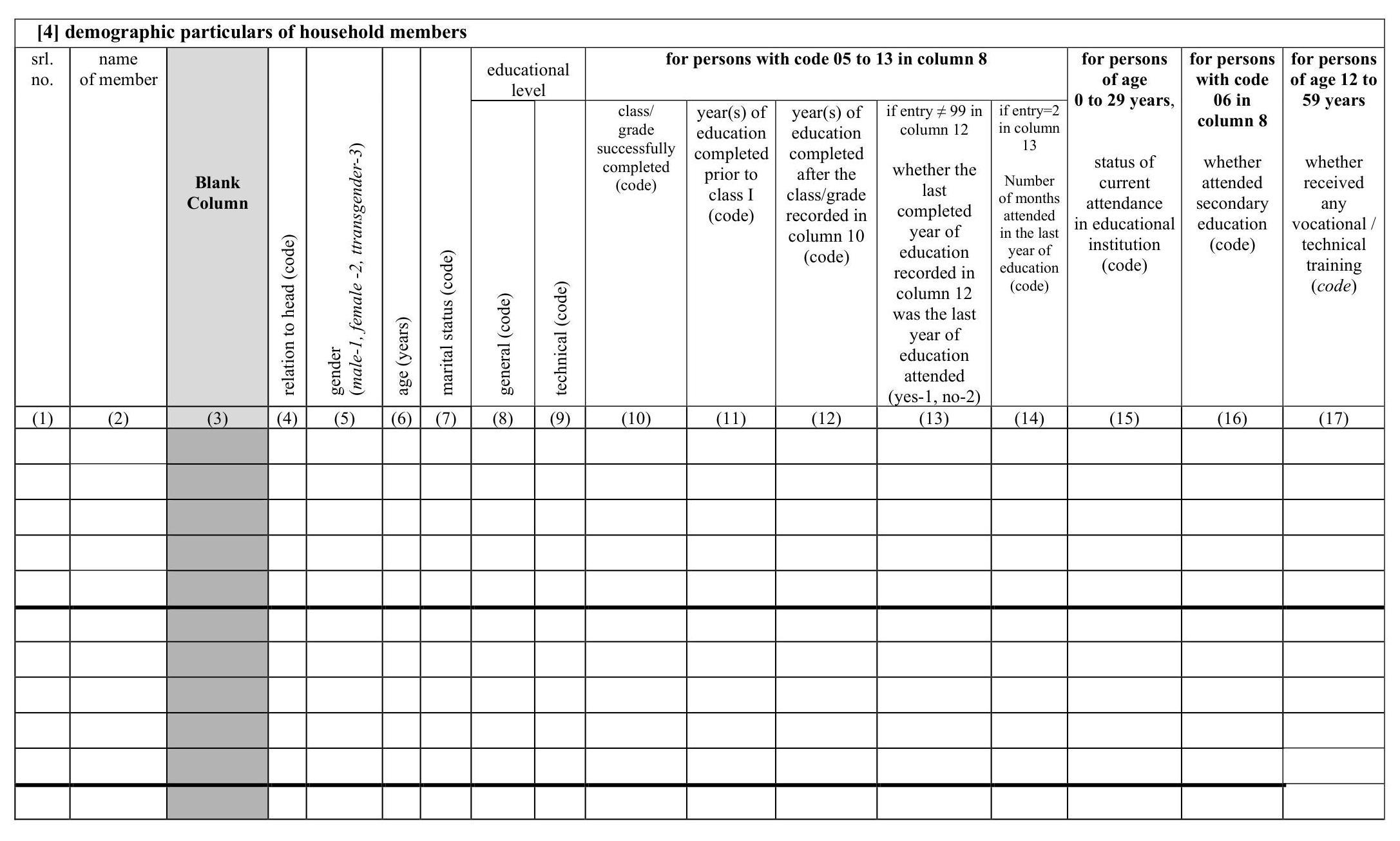
[4.1] formal vocational/technical training particulars of household members of age 12 to 59 years (for those with code 1 in column 17 of Block 4)
| srl. no. as in col.1, bl. 4 |
age (yrs.) as in col.6, bl. 4 |
whether the training was completed during last 365 days (yes-1, no- 2) |
field of training (code) |
duration of training (code) |
type of training (code) |
source of funding the training (govt-1, own funding-2, others-9) |
nature of the certifying body from which vocational / technical training received (code) |
|---|---|---|---|---|---|---|---|
| (1) | (2) | (3) | (4) | (5) | (6) | (7) | (8) |
Codes for Block 4.1
col. (4): field of training:
aerospace and aviation-01, agriculture, non-crop based agriculture, food processing – 02, allied manufacturinggems and jewellery, leather, rubber, furniture and fittings, printing – 03,artisan/craftsman/handicraft/creative arts and cottage based production – 04, automotive – 05, beauty and wellness – 06, chemical engineering, hydrocarbons, chemicals and petrochemicals – 07, civil engineering- construction, plumbing, paints and coatings – 08, electrical, power and electronics – 09, healthcare and life sciences-10, hospitality and tourism – 11, iron and steel, mining, earthmoving and infra building – 12, IT-ITeS -13, logistics – 14, mechanical engineering-capital goods, strategic manufacturing -15, media-journalism, mass communication and entertainment – 16, office and business related work -17, security -18, telecom – 19, textiles and handlooms, appareils – 20, work related to childcare, nutrition, pre-school and crèche -21, other -99 .
col. (5): duration of training:
less than 3 months -1, 3 months or more but less than 6 months-2, 6 months or more but less than 12 months-3, 12 months or more but less than 18 months-4, 18 months or more but less than 24 months-5, 24 months or more-6
col. (6): type of training:
on the job-1, other than on the job: part time-2, full time-3
col. (8): nature of the certifying body from which vocational/technical training received:
School Board/ Technical Board-1, Industrial Training Institute (ITI) -2, Polytechnic -3, NCVET Awarding Body /
Sector Skill Councils-4, Higher Education Institute (University/ College)-5, Others -9
Codes for Block 5.1
col. (3): status:
worked in h.h. enterprise (self-employed): own account worker -11, employer-12, worked as helper in h.h. enterprise (unpaid family worker) -21 ; worked as regular salaried/ wage employee -31 , worked as casual wage labour: in public works -41 , in other types of work -51 ; did not work but was seeking and/or available for work -81 , attended educational institution -91, attended domestic duties only -92, attended domestic duties and was also engaged in free collection of goods (vegetables, roots, firewood, cattle feed, etc.), sewing, tailoring, weaving, etc. for household use -93 , rentiers, pensioners, remittance recipients, etc. -94, not able to work due to disability -95 , others (including begging, prostitution, etc.) -97 .
col. (5): industry: 5-digit code as per NIC -2008.
col. (6): occupation: 3-digit code as per NCO -2015.
col. (8): location of workplace: workplace in rural areas and located in: own dwelling unit-10, structure attached to own dwelling unit-11, open area adjacent to own dwelling unit-12, detached structure adjacent to own dwelling unit13, own enterprise/unit/office/shop but away from own dwelling-14, employer’s dwelling unit -15, employer’s enterprise/unit/office/shop but outside employer’s dwelling -16, street with fixed location-17, construction site-18, others -19 ; workplace in urban areas and located in: own dwelling unit-20, structure attached to own dwelling unit21, open area adjacent to own dwelling unit-22, detached structure adjacent to own dwelling unit-23, own enterprise/unit/office/shop but away from own dwelling-24, employer’s dwelling unit -25 , employer’s enterprise/unit/office/shop but outside employer’s dwelling -26, street with fixed location-27, construction site-28, others -29 ; no fixed workplace -99 .
col. (9): enterprise type: proprietary: male -01 , female -02 ; partnership: with members from same household. -03 , with members from different household -04; Government/local body-05, Public Sector Enterprises-06, Autonomous Bodies- 07, Public/Private limited company-08, Co-operative societies-10, trust/other non-profit institutions -11, employer’s households(i.e., private households employing maid servant, watchman, cook, etc.) -12 , others -19 .
col. (10): number of workers in the enterprise: less than 6-1, 6 and above but less than 10-2, 10 and above but less than 203, 20 and abobe-4, not known-9
col. (11): type of job contract: no written job contract -1 ;written job contract: for 1 year or less -2 , more than 1 year to 3 years -3 , more than 3 years -4 .
col. (13): availability of social security benefits:
eligible for: only PF/ pension (i.e., GPF, CPF, PPF, pension, etc.) -1 ,
only gratuity -2 , only health care/maternity benefits -3 , only $P F /$ pension and gratuity -4 , only $P F /$ pension and health care/ maternity benefits -5, only gratuity and health care/ maternity benefits -6, PF/ pension, gratuity, health care/ maternity benefits -7 ; not eligible for any of above social security benefits -8 , not known-9.
col. (14): what is done with the product of the economic activity in which the household member was engaged in usual principal status:
for own consumption only and did not intend to sell any part of it-1, for own consumption and intended to sell some part of it (less than 50\%)-2, for own consumption and intended to sell major part of it (more than or equal 50\%)-3, the entire produce is for selling -4 .
Codes for Block 5.2
col. (3): status: codes as in col. 3, block 5.1. (only codes 11 to 51 are applicable here).
col. (5) :industry : 5-digit code as per NIC-2008.
col. (6) :occupation : 3-digit code as per NCO-2015.
col. (7): location of workplace : codes as in col. 8, block 5.1.
col. (8): enterprise type: codes as in col. 9, block 5.1.
col.(9): number of workers in the enterprise: codes as in col. 10, block 5.1.
col. (10): type of job contract: codes as in col. 11, block 5.1.
col. (12): availability of social security benefits: codes as in col. 13, block 5.1.
col. (13): what is done with the product of the economic activity in which the household member was engaged in subsidiary economic activity status: codes as in col. 14, block 5.1.
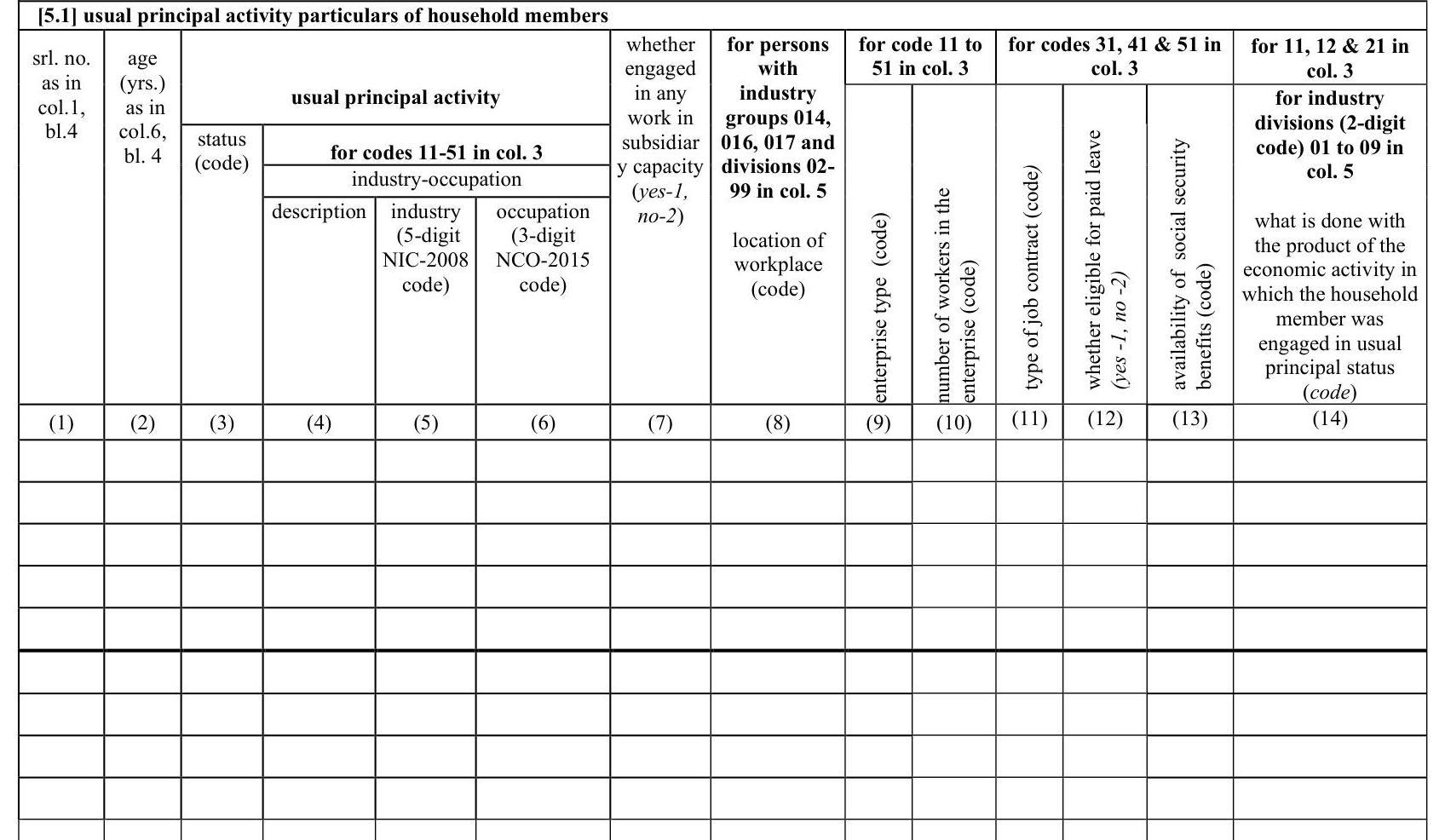
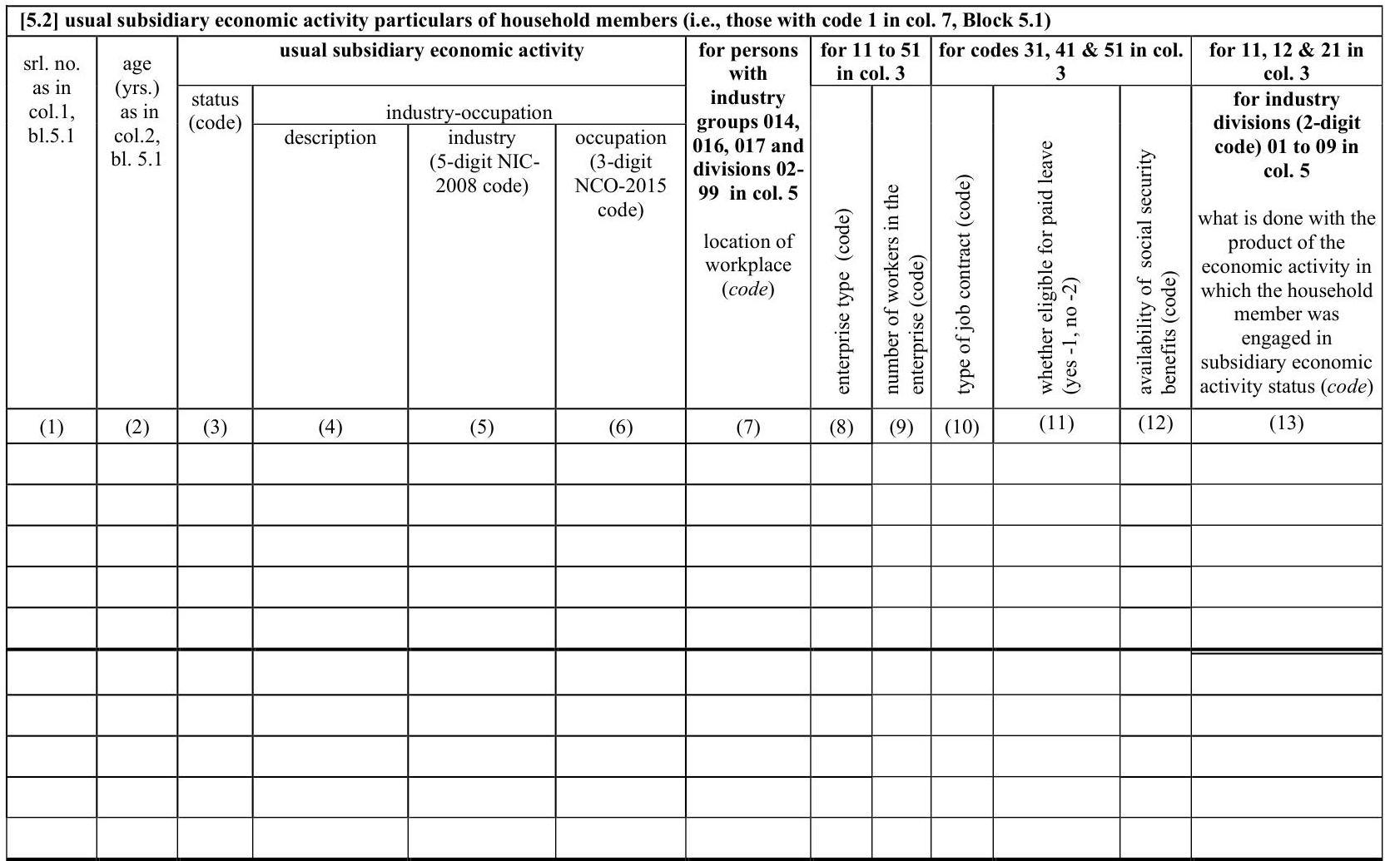
[5.3] Follow-up questions on duration of engagement in economic activity, job search and reason for non-engagement in economic activity
[This block will be filled-up for persons of age 5 years and above]
| srl. no. as in col.1, bl.5.1 | age (yrs.) as in col.2, bl. 5.1 |
usual activity status code | if code 11-51 in col. 3 or col. 4, whether worked in usual status (ps+ss) in the 365 days prior to the reference period of last 365 days preceding the date of survey (yes-1, no-2) | duration of engagement in the economic activity for the workers in usual status | if code 81, in col. 3, what efforts were mainly undertaken to search work? (code) | if code 81, in col. 3 and no entry in column 4 (i.e., without any subsidiary economic activity), duration of this spell of unemployment (code) | if code 81 – 97, in col. 3 and no entry in column 4 (i.e., without subsidiary economic activity), what was the main reason for being in this activity status? (code) | if code 91 – 97, in col. 3 and no entry in column 4 (i.e., without subsidiary economic activity), what was the main reason for being in this activity status? (code) |
|---|---|---|---|---|---|---|---|---|
| principal (as in col. 3, bl.5.1) |
sub- sidiary (as in col. 3, bl.5.2) |
if code 11-51 in col. 3, duration of engagement in the economic activity in usual principal status (code) | if code 11-51 in col. 4, duration of engagement in the subsidiary economic activity (code) | | | ||||
| (1) | (2) | (3) | (4) | (5) | (6) | (7) | (8) | (9) | (10) | (11) | (12) |
| | | | | ||||||||
| | | | | ||||||||
| | | | | ||||||||
| | | | |
Codes for Block 5.3
col. (6)/col. (7): duration of engagement in the economic activity: less than or equal to 6 months-1, more than 6 months but less than or equal to 1 year-2, more than 1 year but less than or equal to 2 years-3, more than 2 years but less than or equal to 3 years-4, more than three years -5
col. (8): what efforts were mainly undertaken to search work: apply to prospective employers/place or answer job advertisements/ check at factories, work sites-1, register with employment exchange-2, register with private employment center-3, seek financial help to start a business-4, seek help from relatives, friends-5, apply for permit or license to start a business-6, others-7
col. (9): duration of this spell of unemployment: less than or equal to 6 months-1, more than 6 months but less than or equal to 1 year-2, more than 1 year but less than or equal to 2 years-3, more than 2 years but less than or equal to 3 years-4, more than three years -5
col. (11): reason for not working: retrenchment/lay-off without pay- 01, end of contract/quit-02, not operating the unit-03, lack of work in the area-04, retiremement05 , child care-06, household responsibilities other than child care-07, health related reasons -08, no financial need-10, others-19
col. (12): reason: did not have the required training/qualification/age for work-1, non availability of work at a convenient location-2, health/age related reason-3, want to continue study-4, social reasons -5, financially well-off-6, child care/personal commitments in home making-7, others-9
| [6] current weekly activity particulars of the household members during the week ended on : | ||||||||
| DD/MM/ YYYY | ||||||||
| srl. no. | ||||||||
| srl. no. | items | details of weekly activity particul | rs of the persons | |||||
| (1) | (2) | |||||||
| 1 | (3) | |||||||
| 2. | age ( years ) | (as in col. 6, block 4) |
- activity status, industry, earnings, hours worked and hours available for additional work
| srl. nos, for day of the week | day of the week | 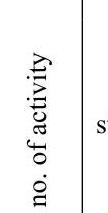 |
status | for 11 – 72 in column 4 | for 41, 42, 51 in column 4, wage earnings (received/ receivable) for the work (Rs.) | |||
|---|---|---|---|---|---|---|---|---|
| industry (2-digit of NIC-2008) for the work activity | hours actually worked (for status codes 11-51)/ hours would have worked (for status codes 61/62/71/72) | total hours actually worked considering all the work performed during the day | if available for additional work, hours available for such work during the day | |||||
| (1) | (2) | (3) | (4) | (5) | (6) | (7) | (8) | (9) |
| 3.1 | $7^{\text {th }}$ day | 1 | ||||||
| 2 | ||||||||
| 3.2 | $6^{\text {th }}$ day | 1 | ||||||
| 2 | ||||||||
| 3.3 | $5^{\text {th }}$ day | 1 | ||||||
| 2 | ||||||||
| 3.4 | $4^{\text {th }}$ day | 1 | ||||||
| 2 | ||||||||
| 3.5 | $3^{\text {rd }}$ day | 1 | ||||||
| 2 | ||||||||
| 3.6 | $2^{\text {nd }}$ day | 1 | ||||||
| 2 | ||||||||
| 3.7 | $1^{\text {st }}$ day | 1 | ||||||
| 2 | ||||||||
| 4. | total hours actually worked during the week/hours available for additional work(total of entries in items 3.1 to 3.7) |
current weekly activity particulars
| 5. | status (code) | ||
|---|---|---|---|
| 6. | for codes | industry (2-digit NIC-2008 code) | |
| 7. | $\mathbf{1 1 – 7 2}$ in item 5, |
occupation (3-digit NCO-2015 code) | |
| 8. | description of the industry-occupation | ||
| 9. | for 31, 71 or 72 in item 5, earnings (received/receivable) during the preceding calendar month for regular salaried/wage activity (Rs.) |
||
| 10. | if entry 11, 12, 61, 62 in item 5, gross earning during last 30 days from self-employment activity (Rs.) |
Note: In items 9 and 10 information will be recorded in respect of the activity identified by the current weekly status (item 5) corresponding industry (item 6) and occupation (item 7).
Codes for block 6
items 3.1 to 3.7 in column 4/weekly activity status (item 5):
codes 11, 12, 21, 31, 51 and 91-95, 97 of col. (3), block-5.1 and also the following codes: worked as casual wage labour in public works other than MGNREG works – 41, worked as casual wage labour in MGNREG works – 42, had work in h.h. enterprise but did not work due to: sickness -61, other reasons -62; had regular salaried/wage employment but did not work due to: sickness -71, other reasons – 72; sought work -81, did not seek but was available for work -82, did not work due to temporary sickness (for casual workers only) -98.
| [3] household characteristics | ||
|---|---|---|
| 1. | household size | |
| 2. | household type (code) | |
| 3. | religion (code) | |
| 4. | social group (code) | |
| 5. | household’s usual monthly consumer expenditure (Rs.) | |
| 5.1 | What is the usual consumer expenditure in a month for household purposes out of purchase of goods and services excluding items like clothing, footwear, durable goods (A): make entry in whole number of rupees [Include: – all regular monthly expenditure incurred by the household for purchase of goods and services for household purposes. – Recurring expenses on telephone bill, electricity bills, etc. which are to be paid once in two months/ quarterly, etc. will be apportioned and reported for a month Exclude: – Any expenditure made by the household for purchase of durable goods. – Unusual expenditures, such as, expenditure on social ceremonies, capitation fee, hospitalization, etc. – Any expenses made on items like clothing, footwear, etc.] |
|
| 5.2 | What is the imputed value of usual consumption in a month from home grown stock like, rice, cereals, pulses, vegetables, milk, firewood, chips, cow dung, etc. (B): make entry in whole number of rupees [If home grown stocks are used on regular basis, the imputed value of such usual consumption in a month at ex-farm/ex-factory price will be recorded] |
|
| 5.3 | What is the imputed value of usual consumption in a month from wages in kind, free collection, gifts, etc. (C): make entry in whole number of rupees [For wage/salaried employees these include free electricity, free telephone services, free medical services, etc. For agricultural labourers these include food-grains, vegetables, meals, etc. It will also include consumption through free collection, or consumption of mid-day meal. Imputation will be made at local retail prices.] | |
| 5.4 | What is the expenditure on purchase of items like clothing, footwear,etc. during last 365 days (D): make entry in whole number of rupees | |
| 5.5 | What is the expenditure on purchase of household durables like bedstead, furniture, vehicles, TV, fridge, fans, cooler, AC, mobile, computer, kitchen equipment, etc. during last 365 days (E): make entry in whole number of rupees | |
| 5.6 | usual monthly household consumer expenditure: $[\mathbf{A}+\mathbf{B}+\mathbf{C}+(\mathbf{D}+\mathbf{E}) / \mathbf{1 2}]$ | |
| 6.1 | land possessed as on the date of survey (code) | |
| 6.2 | land leased-out as on the date of survey (code) | |
| 7 | household’s usual monthly income from the following sources (Rs.) | |
| 7.1 | rent received from land and rental received from building usually in a month: make entry in whole number of rupees | |
| 7.2 | interest received from investment or savings usually in a month: make entry in whole number of rupees | |
| 7.3 | pension received usually in a month: make entry in whole number of rupees | |
| 7.4 | remittances usually received in a month: make entry in whole number of rupees | |
| 7.5 | total of items 7.1 to 7.4: make entry in whole number of rupees |
Codes for Block 3
item 2: household type:
for rural areas: self-employed in: agriculture-1, non-agriculture -2; regular wage/salary earning-3, casual labour in: agriculture-4, non-agriculture -5; others -9.
for urban areas: self-employed -1, regular wage/salary earning -2, casual labour -3, others -9.
item 3: religion: Hinduism -1, Islam -2, Christianity -3, Sikhism -4, Jainism -5,
Buddhism -6, Zoroastrianism -7, others -9.
item 4: social group: scheduled tribe-1, scheduled caste-2, other backward class-3, others-9.
Item 6.1: land possessed as on the date of survey:
| area in acre | code | area in acre | code |
|---|---|---|---|
| less than 0.01 …………… | 01 | $5.0-7.5$ | 07 |
| $0.01-0.05$ | 02 | $7.5-10.0$ | 08 |
| $0.05-0.5$ | 03 | $10.0-15.0$ | 10 |
| $0.5-1.0$ | 04 | $15.0-20.0$ | 11 |
| $1.0-2.5$ | 05 | greater than or equal to 20…… | 12 |
| $2.5-5.0$ | 06 | other | 99 |
Note: 1 acre $=0.4047$ hectare,
Item 6.2: land leased-out as on the date of survey:
| area in acre | code | area in acre | code |
|---|---|---|---|
| less than 0.01 …………… | 01 | $5.0-7.5$ | 07 |
| $0.01-0.05$ | 02 | $7.5-10.0$ | 08 |
| $0.05-0.5$ | 03 | $10.0-15.0$ | 10 |
| $0.5-1.0$ | 04 | $15.0-20.0$ | 11 |
| $1.0-2.5$ | 05 | greater than or equal to 20…… | 12 |
| $2.5-5.0$ | 06 | have not leased-out any land | 99 |
Note: 1 acre $=0.4047$ hectare,
| [1] identification of sample household | |||
|---|---|---|---|
| item no. |
item | code | |
| 22. | tele-phone number* |
22.1 mobile number | |
| 22.2 alternate mobile number | |||
| 22.3 land line (with STD code) |
#: For landline number add the STD code in bracket without zero.
GOVERNMENT OF INDIA
NATIONAL STATISTICS OFFICE SOCIO-ECONOMIC SURVEY PERIODIC LABOUR FORCE SURVEY: JANUARY 2025 – DECEMBER 2025 SCHEDULE 10.4: EMPLOYMENT AND UNEMPLOYMENT (REVISIT)
| $[0]$ descriptive identification of sample household | |||||||||||
|---|---|---|---|---|---|---|---|---|---|---|---|
| 1. state/u.t.: | 6. house number (as in listing schedule): | ||||||||||
| 2. district: | 7. ward /inv. unit: | ||||||||||
| 3. sub-district: | 8. block: | ||||||||||
| 4. town/village:* | 9. name of head of household: | ||||||||||
| 5. village name: | 10. name of informant: |
| [1] identification of sample household | |||||||||||
|---|---|---|---|---|---|---|---|---|---|---|---|
| item no. | item | code | item no. | item | code | ||||||
| 1. | srl. no. of sample village/block | 12. | FOD sub – region | ||||||||
| 2. | schedule number | 1 | 0 | 4 | 13. | Sample Sub-unit (SU) number | |||||
| 3. | sector (rural-1, urban -2) | 14. | sample Sub-division number | ||||||||
| 4. | NSS region | 15. | second-stage stratum number | ||||||||
| 5. | district code | 16. | sample household number | ||||||||
| 6. | stratum | 17. | srl. no. of informant (as in col. 1, block 4 ) | ||||||||
| 7. | sub-stratum | ||||||||||
| 8. | month and year of selection | MM | Y | Y | Y | Y | 18. | response code | |||
| 18. | response code | ||||||||||
| 9. | year ${ }^{5}$ of survey | Y | Y | Y | Y | 19. | survey code | ||||
| 20. | reason for substitution of original household (code) | ||||||||||
| 10. | month of survey (code) | 21. | visit no. | ||||||||
| 11. | panel |
Codes for Block 1
item 9: month of survey:Jan-01, Feb-02, Mar-03, Apr-04, May-05, Jun-06, Jul-07, Aug-08, Sep-09, Oct-10, Nov-11, Dec-12.
item 18: response code: informant: co-operative and capable-1, co-operative but not capable-2, busy-3, reluctant-4, others-9. item 19: survey code: household surveyed -1 , casualty -3 , temporarily absent-9.
\$: Item 9: The year in which Schedule 10.4 was scheduled to be canvassed in the selected household in a particular visit will be entered in this item.
| [2] particulars of field operation | |||||||||
|---|---|---|---|---|---|---|---|---|---|
| srl. no. |
item | Survey enumerator (SE) | Survey supervisor (SS)/ Senior Statistical Officer (SSO) |
||||||
| (1) | (2) | (3) | (4) | ||||||
| 1 (a). | i) name (block letters) | ||||||||
| ii) code | |||||||||
| (iii) signature | |||||||||
| 1 (b). | i) name (block letters) | ||||||||
| ii) code | |||||||||
| (iii) signature | |||||||||
| 2. | date(s) of: (i) survey/ inspection |
DD | MM | YY | DD | MM | YY | ||
| (ii) receipt | |||||||||
| (iii) scrutiny | |||||||||
| (iv) despatch | |||||||||
| 3. | number of additional sheets attached | ||||||||
| 4. | total time taken to canvass Schedule 10.4 (in minutes) |
||||||||
| 5. | signature |
[7] remarks by Survey enumerator (SE)
| [3] household characteristics | ||
|---|---|---|
| 1. | household size | |
| 2. | household type (code) | |
| 3. | religion (code) | |
| 4. | social group (code) | |
| 5. | household’s usual monthly consumer expenditure (Rs.) | |
| 6. | land possessed and leased out as on the date of survey | |
| (item 5.1 to 5.6) | household’s usual monthly income from rent, pension, remittance (Rs.) |
|
| 7. |
Codes for Block 3
item 2: household type:
for rural areas: self-employed in: agriculture-1, non-agriculture -2;regular wage/salary earning-3, casual labour in:agriculture-4, non-agriculture -5; others -9.
for urban areas: self-employed -1, regular wage/salary earning -2, casual labour -3, others -9.
item 3: religion: Hinduism -1, Islam -2, Christianity -3, Sikhism -4, Jainism -5, Buddhism -6, Zoroastrianism -7, others -9 .
item 4: social group: scheduled tribe-1, scheduled caste-2, other backward class-3, others-9.
Codes for Block 4
col. (3): whether a member on the date of revisit: yes: also a member during earlier visit(s)-1, new member: by birth -2 , others -3 ; no: due to death -4 , others -5 .
col. (4):relation to head: self-1, spouse of head-2, married child-3, spouse of married child-4, unmarried child-5, grandchild-6, father/mother/father-in-law/mother-in-law-7, brother/sister/brother-in-law/ sister-in-law/other relatives-8, servants/employees/other non-relatives-9.
col. (7):marital status: never married-1, currently married-2, widowed-3, divorced/separated-4.
col. (8):educational level – general:
not literate -01, literate without formal schooling: $E G S / N F E C / A E C-02, T L C-03$, others -04 ; literate: below primary -05 , primary -06 , middle -07 , secondary -08 , higher secondary -10 , diploma/certificate course 11, graduate -12, postgraduate and above -13 .
col. (9):educational level – technical:
no technical education -01,
technical degree in: agriculture -02, engineering/ technology -03, medicine -04, crafts -05 , other subjects -06
diploma or certificate (below graduate level) in: agriculture -07, engineering/technology -08, medicine -09, crafts -10 , other subjects -11 ;
diploma or certificate (graduate and above level) in: agriculture -12, engineering/technology -13, medicine -14, crafts -15 , other subjects -16 .
col. (10): class / grade successfully completed:
completed: class I-01, class II-02, class III-03, class IV-04, class V-05, class VI-06, class VII-07, class VIII -08, class IX-09, class X-10, class XI-11, class XII-12; did not complete class I – 99.
col. (11): year(s) of education completed prior to class I:
completed: 1 year -1, 2 years – 2, 3 years or more-3, did not complete any years of education prior to class $I-9$.
col. (12): year(s) of education completed after the class/grade recorded in column 10:
first year-01, second year-02, third year-03, fourth year -04, fifth year-05, sixth year -06, seventh year- 07, eighth year- 08, ninth year- 09, tenth year- 10, eleventh year-11, twelfth year-12, thirteenth year-13, fourteenth year-14, fifteenth year-15, sixteenth year-16, seventeenth year-17, eighteenth year and above-18, did not complete any years of education after the class/grade recorded in column $10-99$
col. (14): Number of months in the last year of education:
attended education for less than 3 months in last year education attended-01, attended education for 3 months or more but less than 6 months in last year education attended-02, attended education for 6 months or more but less than 9 months in last year education attended -03 , attended education for 9 months or more in last year education attended -04
col. (15): status of current attendance:
currently not attending:
never attended: school too far -01 , to supplement household income -02 , education not considered necessary 03 , to attend domestic chores -04 , others -05 ;
ever attended but currently not attending: school too far -11 , to supplement household income -12 , education not considered necessary -13 , to attend domestic chores -14 , completed intended level of education -15 , others 16 ;
currently attending in: EGS/ NFEC/ AEC -21, TLC -22, pre-primary (nursery/ Kindergarten, etc.) -23, primary (class I to IV/ V) -24, middle -25, secondary-26, higher secondary-27, graduate in: agriculture -28, engineering/ technology -29, medicine -30, other subjects -31; post graduate and above -32, diploma or certificate (below graduate level) in: agriculture -33, engineering/ technology -34, medicine -35, crafts -36 , other subjects -37; diploma or certificate (graduate level) in: agriculture -38, engineering/ technology -39, medicine -40, crafts -41 , other subjects -42; diploma or certificate in post graduate and above level- 43.
col. (16): whether attended secondary education:
did not enroll in lower secondary or middle level education-01, enrolled in lower secondary or middle level education and did not attend -02 , enrolled in lower secondary or middle level education and attended -03
| [4] demographic particulars of household members | ||||||||||||||
|---|---|---|---|---|---|---|---|---|---|---|---|---|---|---|
| srl. no. (copy from preceding visit for erstwhile members). | name of memb er |
whether a member on the date of re-visit (code)* [for revisit only]n |
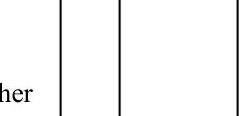 |
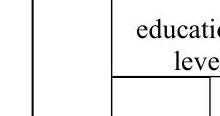 |
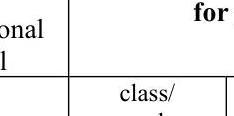 |
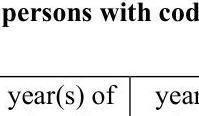 |
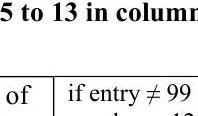 |
for persons with code 05 to 13 in column 8 | for persons of age 0 to 29 years, status of current attendance in educational institution (code) |
for persons of age 12 to 59 years whether received any vocational / technical training (code) |
for persons of age 12 to 59 years whether received any vocational / technical training (code) |
|||
| class/ grade successfully completed prior to class I (code) |
year(s) of education completed prior to class I (code) | year(s) of education completed after the class/grade recorded in column 10 (code) | if entry $\neq 99$ in column 12 whether the last completed year of education recorded in column 12 was the last year of education attended (yes-1, no-2) |
|||||||||||
| (1) | (2) | (3) | (4) | (5) | (6) | (7) | (8) | (9) | (10) | (11) | (12) | (13) | (14) | (15) | (16) | (17) |
| A. erstwhile members | | | | |||||||||||||
| | | | ||||||||||||||
| | | | ||||||||||||||
| | | | ||||||||||||||
| | | | ||||||||||||||
| | | |
*: Codes 1, 4 and 5 are only applicable in Part A
| [4] demographic particulars of household members | ||||||||||||||
|---|---|---|---|---|---|---|---|---|---|---|---|---|---|---|
| $\begin{aligned} & \text { srl. no. } \ & \text { (give } \ & \text { continu } \ & \text { ous srl. } \ & \text { numbe } \ & \text { r from } \ & \text { part A) } \end{aligned}$ | name of member | whether a member on the date of re-visit (code)* [for revisit only]n |
whether a h in in in in in |
 |
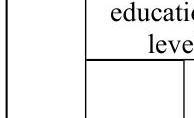 |
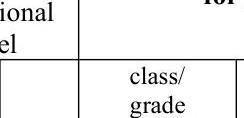 |
 |
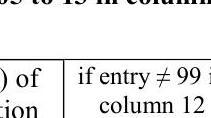 |
for persons of age 0 to 29 years, status of current attendance in educational institution (code) |
for persons of age 12 to 59 years whether received any vocational / technical training (code) |
||||
| (1) | (2) | (3) | (4) | (5) | (6) | (7) | (8) | (9) | (10) | (11) | (12) | (13) | (14) | (15) | (16) | (17) |
| B. New members | | | | |||||||||||||
| | | | ||||||||||||||
| | | | ||||||||||||||
| | | | ||||||||||||||
| | | | ||||||||||||||
| | | | ||||||||||||||
| | | |
- Codes 2 and 3 are only applicable in Part B
[6] current weekly activity particulars of the household members (for those who are household members as on the date of survey, i.e., for those with codes 1,2 or 3 in col. 3 of block 4) during the week ended on :
| DD/MM/ | |||
|---|---|---|---|
| srl. no. | items | details of weekly activity particulars of the persons | |
| (1) | (2) | (3) | |
| 1 | srl. no. of member (as in col. 1, block 4) | ||
| 2. | age ( years ) (as in col. 6, block 4) | ||
| 3. activity status, industry, earnings, hours worked and hours available for additional work | |||
| srl. nos. for day of the week | day of the week | 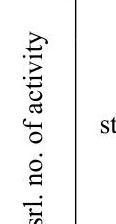 |
status | for 11 – 72 in column 4 | | | for 41, 42, 51 in column 4, wage earnings (received/ receivable) for the work (Rs.) |
| | industry (2-digit of NIC-2008) for the work activity | hours actually worked (for status codes 11-51)/ hours would have worked (for status codes 61/62/71/72) | total hours actually worked considering all the work performed during the day | | |||
| (1) | (2) | (3) | (4) | (5) | (6) | (7) | (8) | (9) |
| 3.1 | $7^{\text {th }}$ day | 1 | | | | | | |
| 2 | | | | | | | ||
| 3.2 | $6^{\text {th }}$ day | 1 | | | | | | |
| 2 | | | | | | | ||
| 3.3 | $5^{\text {th }}$ day | 1 | | | | | | |
| 2 | | | | | | | ||
| 3.4 | $4^{\text {th }}$ day | 1 | | | | | | |
| 2 | | | | | | | ||
| 3.5 | $3^{\text {rd }}$ day | 1 | | | | | | |
| 2 | | | | | | | ||
| 3.6 | $2^{\text {nd }}$ day | 1 | | | | | | |
| 2 | | | | | | | ||
| 3.7 | $1^{\text {st }}$ day | 1 | | | | | | |
| 2 | | | | | | | ||
| 4. | total hours actually worked during the week/hours available for additional work(total of entries in items 3.1 to 3.7) | | | | | | | |
| current weekly activity particulars | | | | | | | ||
| 5. | status (code) | | | | | | | |
| 6. | for codes 11-72 in item 5, | industry (2-digit NIC-2008 code) | | | | | | |
| 7. | occupation (3-digit NCO-2015 code) | | | | | | | |
| 8. | description of the industry-occupation | | | | | | | |
| 9. | for 31, 71 or 72 in item 5, earnings (received/receivable) during the preceding calendar month for regular salaried/wage activity (Rs.) | | | | | | | |
| 10. | if entry 11, 12, 61, 62 in item 5, gross earning during last 30 days from self-employment activity (Rs.) | | | | | | |
Note: In items 9 and 10 information will be recorded in respect of the activity identified by the current weekly status (item 5) corresponding industry (item 6) and occupation (item 7).
Codes for Block 6
items 3.1 to 3.7 in column 4/ weekly activity status (item 5):
worked in h.h. enterprise (self-employed): own account worker -11, worked in h.h. enterprise (self-employed): employer-12, worked as helper in h.h. enterprise (unpaid family worker) -21; worked as regular salaried/ wage employee -31, worked as casual wage labour in public works other than MGNREG works – 41, worked as casual wage labour in MGNREG works – 42, worked as casual wage labour in other types of work (other than public work) -51; had work in h.h. enterprise but did not work due to:
sickness -61,
other reasons -62 ;
had regular salaried/wage employment but did not work due to:
sickness -71,
other reasons – 72 ;
sought work -81,
did not seek but was available for work -82 ,
attended educational institution -91,
attended domestic duties only -92,
attended domestic duties and was also engaged in free collection of goods (vegetables, roots, firewood, cattle feed, etc.), sewing, tailoring, weaving, etc. for household use -93,
rentiers, pensioners, remittance recipients, etc. -94,
not able to work due to disability -95,
others (including begging, prostitution, etc.) -97.
did not work due to temporary sickness (for casual workers only) -98.
| [1] identification of sample household | |||
|---|---|---|---|
| item no. |
item | code | |
| 22. | 22.1 mobile number | ||
| 22.2 alternate mobile number | |||
| 22.3 land line (with STD code) |
#: For landline number add the STD code in bracket without zero.
Dissemination of NSS Results :
The Report is available in the website of Ministry of Statistics \& Programme Implementation (www.mospi.gov.in)
- ${ }^{1}$ The ‘Sample Design and Estimation Procedure’ used in PLFS upto December 2024 may be perused as Appendix D in the Annual Report, PLFS: 2023-24, which is accessible at www.mospi.gov.in ↩